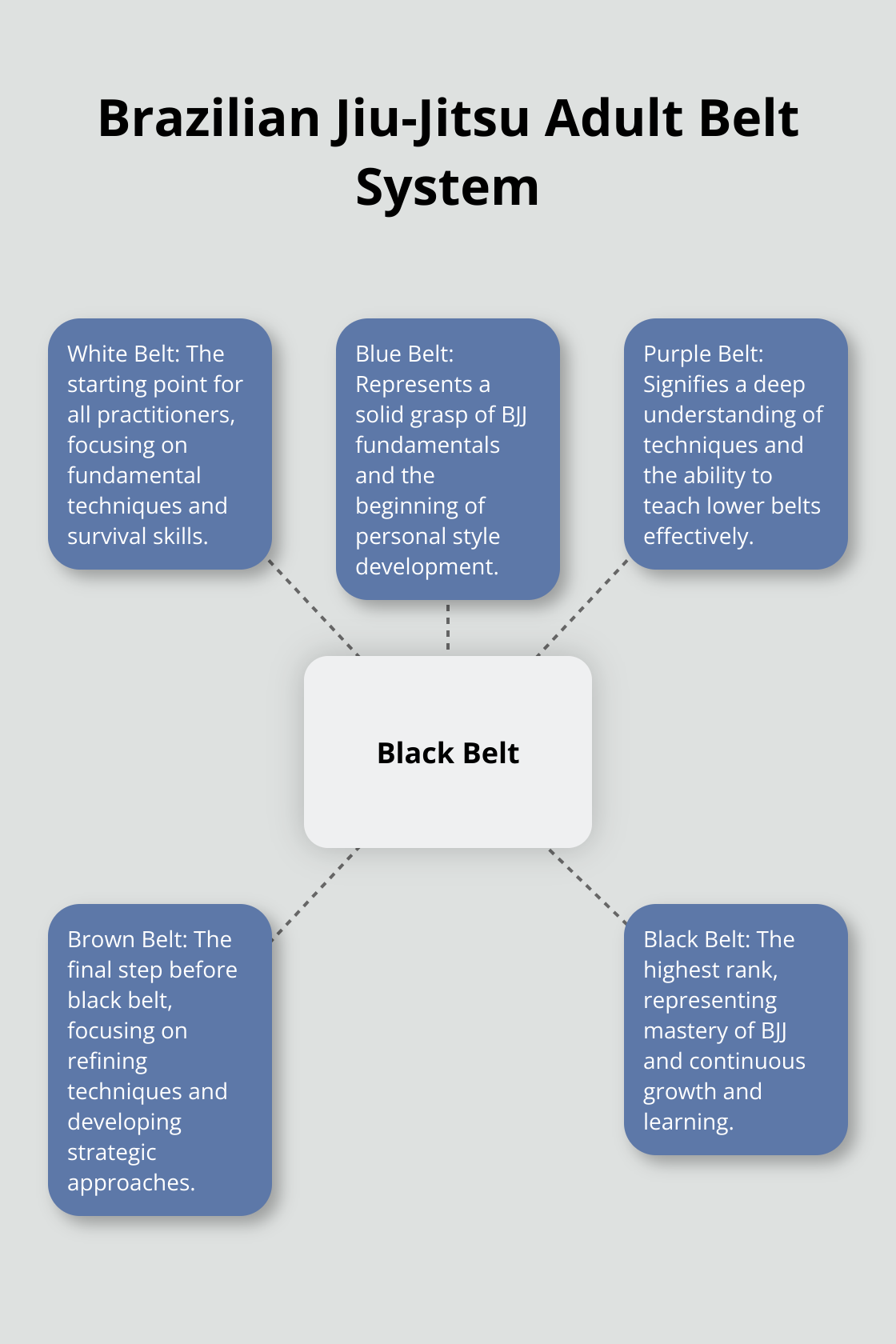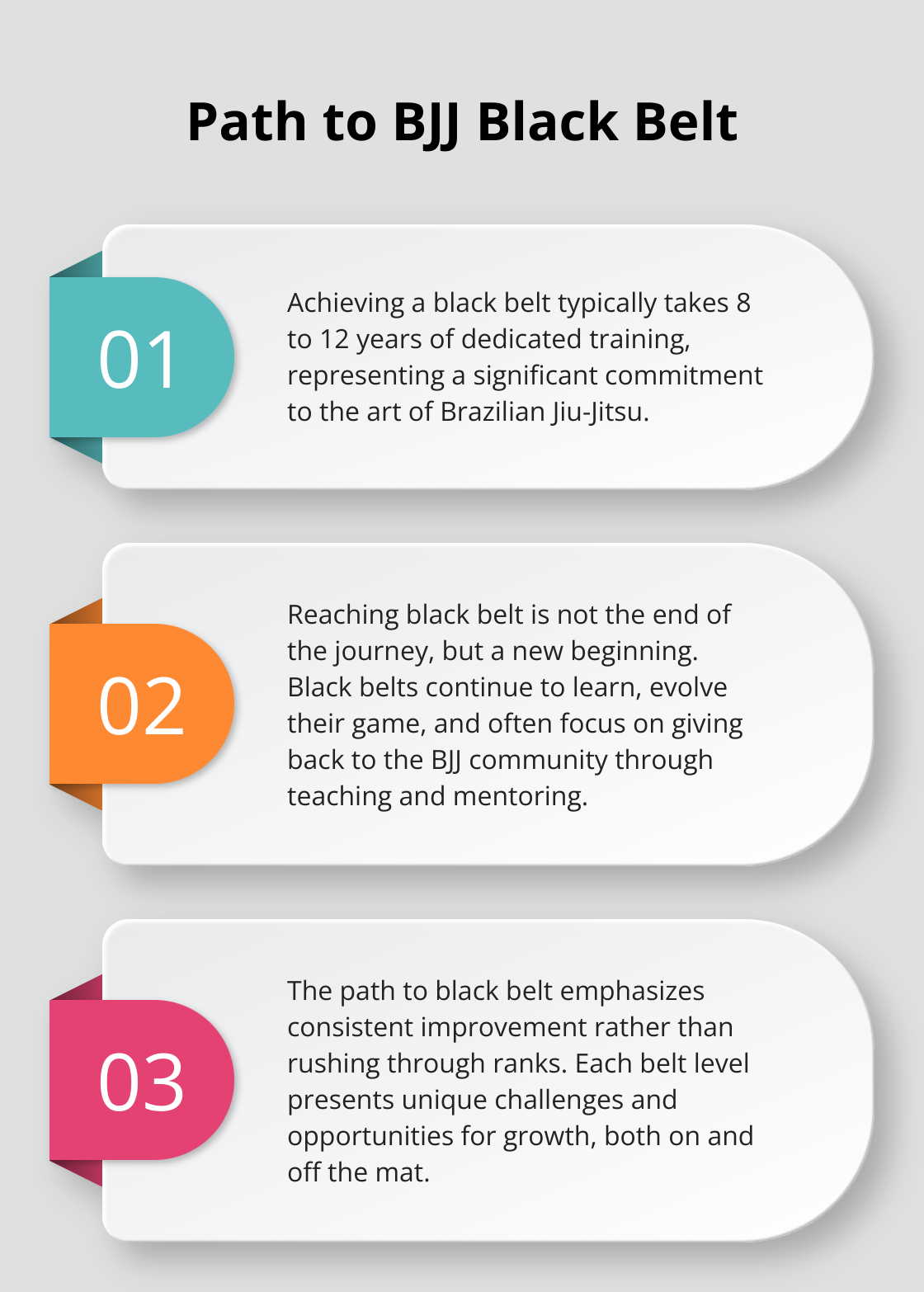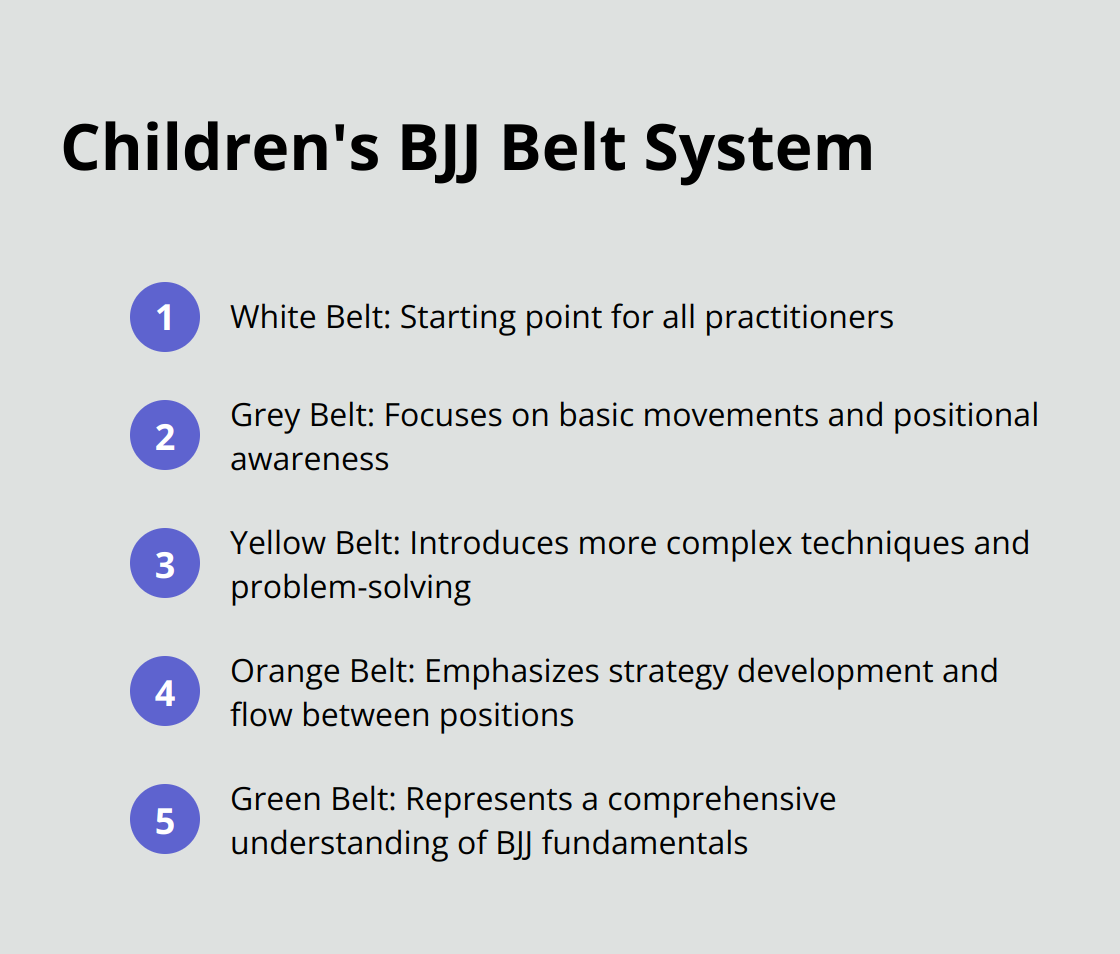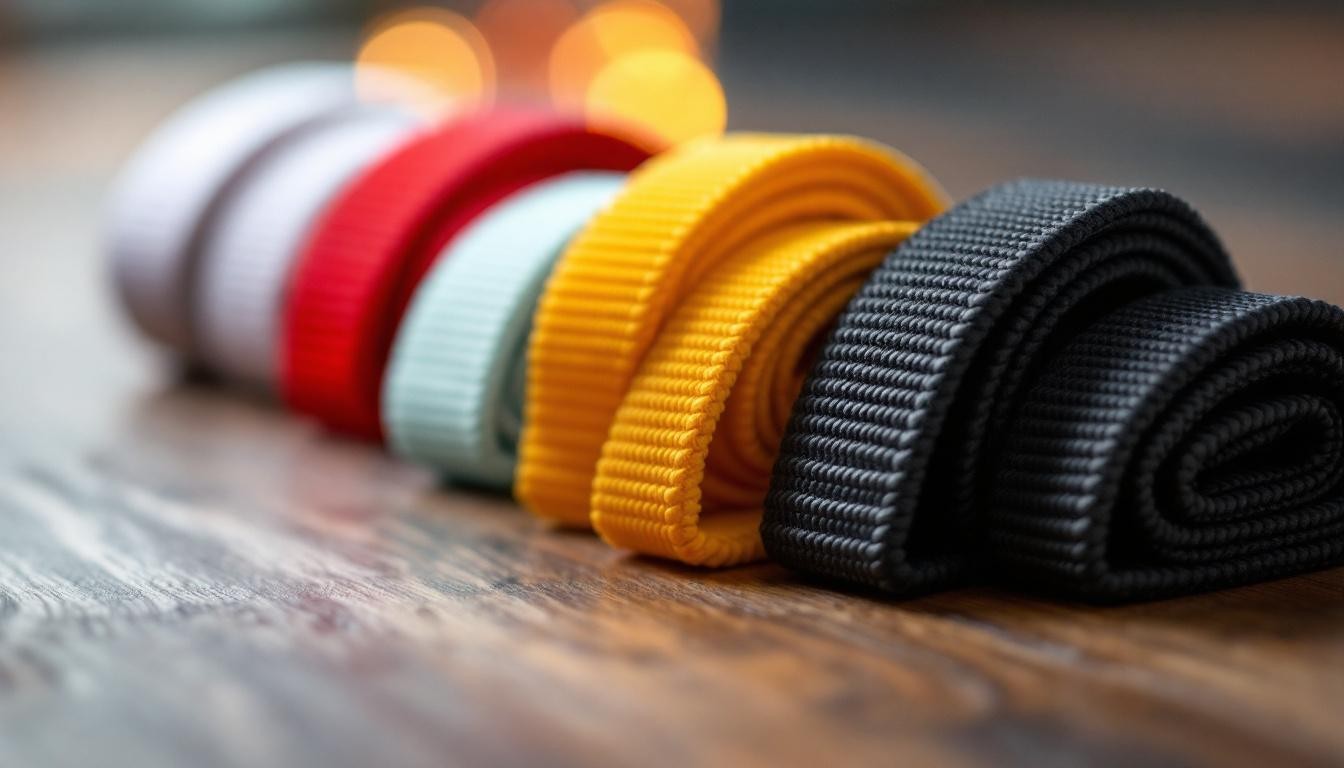At Jiu jitsu, we believe understanding the Brazilian Jiu Jitsu belt order is essential for every practitioner’s journey.
The belt system in BJJ serves as a roadmap for progress, reflecting years of dedication and skill development.
In this post, we’ll explore the traditional belt ranks, their significance, and the effort required to advance through each level.
Understanding BJJ Belt Ranks
The Foundation of BJJ Progression
The Brazilian Jiu-Jitsu (BJJ) belt system provides a structured method to track a practitioner’s progress and skill level. At Souza Grappling Co., we adhere to the traditional BJJ belt ranking system, which consists of five main adult belts: white, blue, purple, brown, and black. Each belt has multiple stripes, marking progress within each rank.

White Belt: The Novice Stage
Every BJJ journey starts with the white belt. This rank represents the beginner stage, where practitioners learn fundamental techniques, positions, and escapes. The duration at white belt varies, but it typically takes consistent training to advance to blue belt.
Blue Belt: Solidifying the Basics
Blue belt signifies a solid grasp of BJJ fundamentals. At this stage, practitioners refine their techniques and start to develop their own style.
Purple Belt: Mastering Advanced Techniques
Purple belt often represents the middle ground of BJJ expertise. Practitioners at this level demonstrate a deep understanding of techniques and can effectively teach lower belts.
Factors Influencing Belt Progression
Advancement through the ranks requires more than just time on the mat. Consistent attendance, technical proficiency, and performance in sparring sessions (known as “rolling”) all play crucial roles in belt promotions. Some academies also consider competition results when evaluating a student’s readiness for advancement.
It’s important to note that belt promotions are subjective and can vary between instructors and academies. Individual instructors have the final say in their students’ promotions.
At Souza Grappling Co., we place emphasis on personal growth and skill development over rapid belt progression. Our experienced instructors carefully assess each student’s progress, ensuring that promotions are earned through dedication and improvement.
As practitioners progress through the belt ranks, they not only improve their technical skills but also develop mental fortitude and a deeper understanding of BJJ philosophy. The journey from white to black belt is a transformative experience that extends far beyond the mats.
Adult BJJ Belt Progression: What to Expect?
White Belt: The Foundation
White belts focus on survival and basic techniques. This stage typically lasts 1-2 years, depending on training frequency and dedication. You’ll learn fundamental positions, escapes, and submissions. Don’t let frequent taps discourage you – they’re part of the learning process. Try to attend classes 2-3 times a week and supplement with strength and conditioning exercises to build your BJJ-specific fitness.
Blue Belt: Game Development
Reaching blue belt is a significant milestone (often taking 2-3 years of consistent training). At this stage, you’ll start to develop your own BJJ style. Refine techniques and create combinations. Many blue belts experience a plateau – push through by setting specific goals for each training session. Compete in local tournaments to test your skills and identify areas for improvement.
Purple Belt: Advanced Concepts
Purple belt represents a deep understanding of BJJ principles. This rank usually takes 3-5 years to achieve from blue belt. You’ll grasp the nuances of timing and pressure. Experiment with more advanced techniques and focus on developing a well-rounded game. Consider cross-training in wrestling or judo to enhance your takedown skills. Many purple belts begin to assist in classes, which can accelerate their own learning.
Brown Belt: Expertise Refinement
Brown belt is the final step before black belt (often taking 1-3 years to achieve from purple). At this level, you’ll refine your techniques and develop a strategic approach to rolling. Focus on efficiency and energy conservation. Analyze high-level competition footage to understand advanced strategies. Many brown belts start competing at the elite level – use these experiences to identify and address any weaknesses in your game.
Black Belt: Continuous Growth
Achieving a black belt typically takes 8 to 12 years of dedicated training. However, this isn’t the end of the journey – it’s a new beginning. Black belts continue to learn and evolve their game. Many focus on giving back to the BJJ community through teaching and mentoring. Set new challenges for yourself, such as competing in major tournaments or exploring different grappling styles to keep your BJJ fresh and engaging.

These timeframes are averages – your journey may differ. Focus on consistent improvement rather than rushing through ranks. Each belt level presents unique challenges and opportunities for growth, both on and off the mat. As you progress through the adult ranks, you’ll notice significant changes in your skills and mindset. Next, let’s explore how the belt system differs for younger practitioners in the Children’s BJJ Belt System.
How Does the Children’s BJJ Belt System Work?
A Tailored Approach for Young Practitioners
The children’s BJJ belt system differs significantly from the adult ranking structure. This system keeps young students motivated and engaged throughout their journey.
Children’s Belt Colors and Their Meanings
The children’s BJJ belt system typically includes white, grey, yellow, orange, and green belts. Each color represents a stage in a child’s development, both in technique and maturity.
White belt remains the starting point for all practitioners. Children then progress through:

- Grey belt (beginner): Focuses on basic movements and positional awareness
- Yellow belt (intermediate): Introduces more complex techniques and encourages problem-solving
- Orange belt (advanced): Emphasizes strategy development and flow between positions
- Green belt (expert): Represents a comprehensive understanding of BJJ fundamentals
Each of these belts may have up to four stripes, indicating progress within that rank.
Transitioning to the Adult System
The transition from the children’s to the adult belt system typically occurs around age 16. This transition can challenge young practitioners, as they move from being at the top of the children’s ranks to starting again as adult white or blue belts.
Many academies implement a gradual approach to ease this transition. For instance, a 15-year-old green belt might receive a white belt with three or four stripes upon entering the adult program (acknowledging their previous experience while aligning with adult ranking standards).
Age-Appropriate Training and Promotion
Children’s promotions often occur more frequently than in the adult system, usually every 6-12 months. This faster progression helps maintain motivation and rewards consistent effort. However, promotions still depend on skill development, attendance, and overall growth rather than just time spent training.
Age-appropriate training methods include:
- Ages 4-7: Classes focus on fundamental movements, discipline, and fun
- Ages 8-12: More technical instruction
- Ages 13-15: Begin to incorporate adult-level techniques and sparring
Balancing Competition and Development
Competition can serve as a valuable tool for growth, but it’s important to balance competitive goals with overall development. Participation in age and weight-appropriate tournaments can benefit young practitioners, but competition results should not be the sole factor in belt promotions.
Final Thoughts
The Brazilian Jiu-Jitsu belt order provides structure, but true progress extends beyond belt colors. We at Souza Grappling Co. believe that dedication, perseverance, and continuous improvement define a practitioner’s journey. Physical fitness, mental resilience, and a strong sense of community are invaluable benefits that accompany BJJ training.
We encourage practitioners to focus on individual growth rather than comparisons with others. Every BJJ journey is unique, with progress occurring at different rates for each person. Embrace the learning process, celebrate small victories, and view setbacks as opportunities to improve your skills.
At Souza Grappling Co., we offer a supportive environment for BJJ practitioners of all levels (from beginners to advanced). Our expert instructors guide students through each stage of the Brazilian Jiu-Jitsu belt order, fostering both technical proficiency and personal development. Join us to explore your potential in Brazilian Jiu-Jitsu and experience the transformative power of this martial art.




